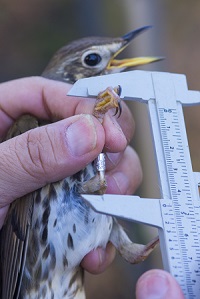A study led by the Doñana Biological Station (EBD-CSIC) found that fruit-eating birds (frugivorous) in Doñana have experienced negative changes in the last 40 years: a decrease in their abundance, a lower fat reserve, and advances in their migratory timing.
This could be due to vegetation shifts and increasing temperatures associated with climate change. Changes in the timing of migratory birds' arrivals and departures can lead to a lack of synchronization between birds and fruit production, which has consequences for the plants since it affects the seed dispersal services birds carry out
In the last 40 years, fruit-eating birds (frugivorous) in Doñana have experienced changes in abundance, physical condition, and migratory timing, according to a recently published study led by researchers associated with the Doñana Biological Station (EBD-CSIC). These birds are important for the natural regeneration of many tree and bush species depending on them to disperse their seeds. This work highlights the vulnerability of these fruit-eating birds under the effects of climate change and land use, affecting the regeneration of fruiting plants, which are in turn their food supplier.
Finding uninterrupted information on birds in recent decades is complicated but this study used a historical sampling carried out during 1981-1983 by Pedro Jordano, Research Professor at the Doñana Biological Station – CSIC. This very sampling was repeated during 2019-2021. In this way, the team could prove the negative trend of frugivorous birds in Doñana. This area, known as a passage area for migratory species, has experienced changes in temperature and vegetation because of human action.
This work, carried out by ecologists and a bird ringing and banding team, shows worrying changes in frugivorous species. There is currently a lower abundance of wintering and seed-disperser species (a 66% and 18,4% decrease respectively) and they have been replaced by woodland, resident (non-migratory), and insectivorous birds. Likewise, on a seasonal scale, some frugivorous species (9 of 11) have their peak in abundance one month earlier compared to the 1980s. This could be due to a response to earlier fruit production. In addition to these phenological changes, the study has analyzed these birds' physical conditions. Besides being fewer, they have poorer body conditions compared to the past: they show fewer fat reserves and lower body weight than expected according to their size.
Irene Mendoza, a postdoctoral researcher at the Doñana Biological Station - CSIC and corresponding author of the article, highlights the importance of the study: "We should ideally have analyzed 40 year-uninterrupted data, but this long-term ecological information is unfortunately very complicated to get. Luckily, we have the data collected by Pedro Jornado in the 80s, which provided a good opportunity to compare them with current data. Therefore, we have repeated the same sampling protocol in the framework of my Marie-Curie-funded project. We could thus conclusively verify that the frugivorous birds of Doñana are being negatively affected by human action".
These changes probably have their explanation in the current global change context. On the one hand, the area studied (Hato Ratón, Villamanrique de la Condesa, Seville) has experienced vegetation changes. The researchers detected a considerable increase in forest cover and a larger abundance of stone pines compared to the 80s, when scrublands with fleshy-fruited species dominate, especially the mastic and wild olive. On the other hand, increasing temperatures associated with climate change are related to changes in the timing of migratory birds' arrivals and departures, as well as to their abundance peak. The lack of synchronization between the bird's arrival and the fleshy-fruit production can lead to them having less fat accumulation, which is critical for birds' survival during migration and wintering, when they require a large energy reserve.
These dramatic results reveal the vulnerability of fruit-eating birds to anthropic action. The loss of frugivorous birds can cause a seed dispersal decrease and an interruption in the life cycle of fleshy-fruited plants, which in turn affects the food availability for these birds. However, the extent of these effects still remains to be seen. According to María Campo-Celada, the first author of the article, "although we have quantified these alterations on a local scale, they are probably reflecting situations currently taking place in a multitude of ecosystems, as is being documented in numerous studies. Although the are more and more evidence, the difficulty in controlling the global change drivers leads us into an uncertain future"
According to Pedro Jordano, Spanish National Research Award (2018) and co-author in the article, "the study shows how frugivorous birds and plants depend on each other to persist and complete their life cycles. We are witnessing more accelerated and negative changes than we might think; changes occurring in short time periods and with great significance. The conservation of the Mediterranean forest depends on the persistence of these mutualistic interactions plants and animals ".
Reference:
María Campo-Celada, Pedro Jordano, Ana Benítez-López, Carlos Gutiérrez-Expósito, Julio Rabadán-González, Irene Mendoza, 2022. Assessing short and long-term variations in diversity, timing and body condition of frugivorous birds. OIKOS. https://doi.org/10.1111/oik.08387
https://doi.org/10.1111/oik.08387









 Las altas temperaturas están provocando que las lagunas y las marismas de Doñana pierdan agua rápidamente
Las altas temperaturas están provocando que las lagunas y las marismas de Doñana pierdan agua rápidamente



